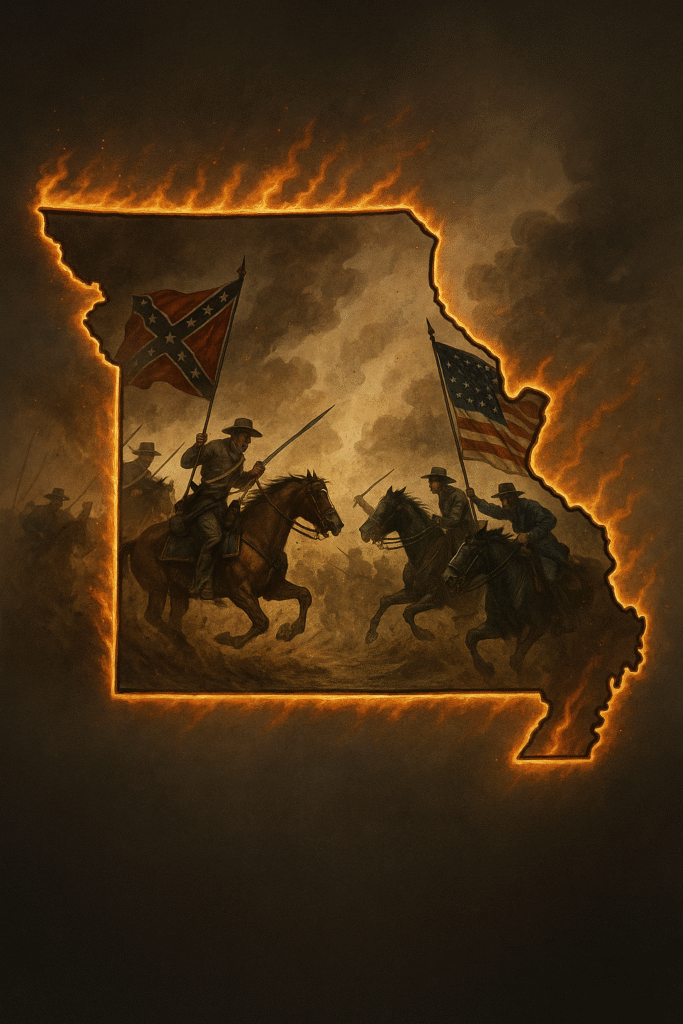Before the Civil War, Missouri was already burning. Discover how Bleeding Kansas, Border Ruffians, and guerrilla raids primed the state for chaos.
Table of Contents
Missouri’s War Before the War
When people think of the Civil War in Missouri, most imagine Union and Confederate soldiers clashing in 1861. But in truth, Missouri was already at war years earlier. The 1850s saw neighbors turn on neighbors, towns torched, and guerrilla raids launched across the Kansas border. This violent prelude became known as Bleeding Kansas, and it set the stage for the chaos that would consume Missouri once the national war began.
The Kansas-Nebraska Act: Lighting the Fuse
In 1854, Congress passed the Kansas-Nebraska Act. It overturned the Missouri Compromise of 1820 and allowed settlers to decide whether Kansas would permit slavery — a policy called “popular sovereignty.” On paper, it sounded democratic. In practice, it was gasoline on dry grass.
Both pro-slavery Missourians and anti-slavery settlers from the North rushed into Kansas to tip the balance. For Missourians, Kansas was their backyard — and they were determined not to see it fall into the hands of abolitionists.
The Border Ruffians Ride In
Pro-slavery Missourians became infamous as Border Ruffians. These armed bands crossed into Kansas to stuff ballot boxes, intimidate settlers, and use violence to preserve slavery’s expansion.
They didn’t just vote — they carried muskets, torches, and Bowie knives. They burned Free-State settlements, threatened abolitionist leaders, and established a culture of fear along the frontier.
Free-Staters and Abolitionist Defiance
The Border Ruffians found fierce resistance. Northern abolitionists, many financed by New England “Emigrant Aid Societies,” moved to Kansas with the express purpose of stopping slavery’s spread. These “Free-Staters” formed militias, built fortified towns like Lawrence, and met violence with their own.
It was a clash of worlds — pro-slavery Missourians determined to protect their way of life, and abolitionists equally determined to block them.
Blood on the Border
The conflict escalated into open violence. In 1856, abolitionist John Brown and his followers struck back with the Pottawatomie Massacre, hacking five pro-slavery settlers to death in retribution. Raids, ambushes, and retaliations followed on both sides.
The Missouri-Kansas border became a testing ground for the brutal tactics that would later define guerrilla warfare during the Civil War. Homes were burned, families were uprooted, and the idea of “neighbor against neighbor” became daily reality.
Missouri’s Reputation for Violence
By the end of the 1850s, Missouri carried a reputation for lawlessness. What unfolded in Bleeding Kansas wasn’t just a political debate — it was a mini civil war. The violence blurred the line between soldier and outlaw, and the scars it left would never fully heal.
When the national Civil War erupted in 1861, Missouri didn’t start from zero. It had already been bloodied. Guerrilla tactics, bitter divisions, and a culture of vengeance were deeply rooted. The Civil War simply poured fuel on an already raging fire.
Why Bleeding Kansas Matters for Missouri
Understanding Bleeding Kansas explains why Missouri’s Civil War was unlike anywhere else. Unlike states that faced their first real test in 1861, Missourians had been fighting for nearly a decade.
So when Union General Nathaniel Lyon stomped down on Missouri in 1861, he wasn’t quelling peace — he was stepping into a battlefield already aflame.
Explore Bleeding Kansas – Missouri–Kansas Border
Today, you can still trace the scars of Bleeding Kansas along the Missouri-Kansas border. Historic sites like the John Brown Museum in Osawatomie, the Free State town of Lawrence, and pro-slavery strongholds near Westport offer a window into this violent frontier. Walking these sites connects you to the struggles that shaped Missouri before the first official shots of the Civil War.
Plan Your Next Missouri Civil War Adventure!
Ready to hit the road?
Plan your Missouri Civil War adventure with trusted travel tips, tools, and resources. Visit our Resource Page (Missouri Civil War Resources) to find everything you need for hotels, flights, car rentals, gear, and more.
Check Out These Other Civil War Articles
Missouri Civil War: Why This Forgotten Story Matters
Civil War In Missouri: 6 Questions You Should Ask
Check Out These Books Published By The Sojourner’s Compass
“Battles & Beyond” – Companion Book Series
From river crossings to ridge fights, Missouri’s Civil War story was one of chaos, courage, and contested loyalties. This travel-ready series delivers concise battlefield guides packed with historical context, walking tips, firsthand quotes, and itinerary tie-ins—perfect for travelers, educators, and armchair historians alike.
Led by Jonathon Midgley, author of The Last Hand series, each volume brings forgotten fights into clear focus—making it easy to explore the war’s impact, one battlefield at a time.
Available On Amazon & Kindle Unlimited
How to Plan a Budget-Friendly Getaway in Missouri: Smart Travel Strategies for Affordable Adventures
Explore Missouri with confidence, strategy, and style—without breaking the bank. This guide delivers smart travel tools, scenic itineraries, and insider tips on lodging, dining, and hidden gems across the state.
Whether you’re road-tripping solo or planning a family escape, this eBook is your map to affordable adventure and stress-free travel.
Available On Amazon & Kindle Unlimited
Stay Connected
Follow us for travel inspiration, new articles, and short-form video features:
The Sojourner’s Compass TikTok
The Sojourner’s Compass YouTube
The Sojourner’s Compass Facebook
The Sojourner’s Compass Main Website


Leave a Reply